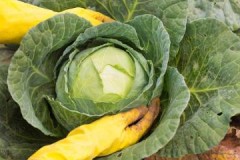Features, advantages and disadvantages of storing cabbage in cling film
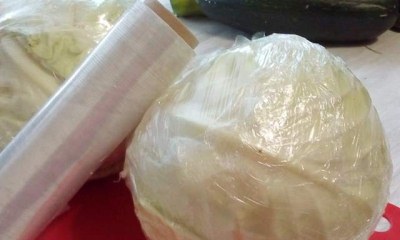 Cabbage is satisfying and healthy, but it's hard to use more than one fork at a time.
Cabbage is satisfying and healthy, but it's hard to use more than one fork at a time.
Housewives who have bought too large a head of cabbage and gardeners who have gathered an impressive harvest face the problem of extending the shelf life of the product.
If you just put vegetables in the refrigerator, they will quickly become moldy, and there is not so much space in it. In such cases, polyethylene comes to the rescue.
Read about whether and how to properly store fresh cabbage in cling film in the article.
Content
Can I store?
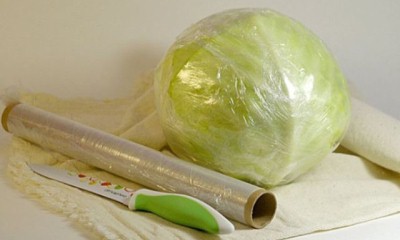 Store cabbage in cling film is possible, but this method is not always applicable... For example, this method is not suitable for long-term storage.
Store cabbage in cling film is possible, but this method is not always applicable... For example, this method is not suitable for long-term storage.
If the product stays in the stretch for more than 4 months, it will start to deteriorate.
Wrapped in polyethylene, both whole and cut into 2 parts forks... The halves are used in the first place, since a violation of the integrity of the vegetable leads to the settling of microbes on its surface.
Therefore, after 10-15 days, it will start to deteriorate. Whole cabbages last longer.
Pros and cons
Storing cabbage in cling film has its advantages and disadvantages. The advantages of the method include:
- Keeping moisture inside the plug. Its leaves are more than 90% water. Its loss for a vegetable is disastrous, but thanks to the stretch, it does not dry out, since contact with oxygen is minimized.
- Ease of use. The process of wrapping the fork with plastic will not take longer than 5 minutes.
- Method availability. There will be no problems with buying cling film. It is sold in any hardware store and is very cheap (around RUB 50 per roll).
This method has several disadvantages, including:
- Short shelf life. If the fork has already been cut, then under the film it will lie no more than 2 weeks.
- The need for regular monitoring. Whole cabbage wrapped in plastic should be inspected at least once a month. The accumulation of condensation is a sure way for bacteria to multiply.
- Possibility of storing only "ideal" heads of medium size. The presence of even one small defect will lead to damage to the vegetable.
Preparing a fresh vegetable
Before wrapping a vegetable in plastic, you need to properly prepare it. Highlights:
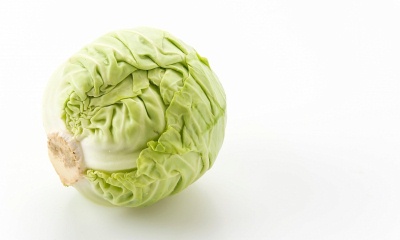 Inspect the head of cabbage from all sides.It should not have visible defects, infected areas. Even clean cracks without signs of rot are a reason to stop using the film.
Inspect the head of cabbage from all sides.It should not have visible defects, infected areas. Even clean cracks without signs of rot are a reason to stop using the film.- Assess the structure of the cabbage. Elastic heads of cabbage are removed for long-term storage. All leaves should fit tightly to each other. Loose specimens are not wrapped in film.
- Estimate the size of the heads. Medium forks are suitable for long-term storage.
- Using a sharp knife, cut off the leg of the cabbage. The cut must be made as close to the base as possible.
- Rinse the forks under cool running water to remove dust, dirt, and bacteria.
- Let the vegetables dry. In the fresh air, cabbage should lie for at least an hour.
- Cool it down to storage temperature. If the cabbage is lowered into the cellar, then it is left in it for a day. Only then is it wrapped in stretch.
In the cellar and refrigerator
In cling film, the product can be stored in the refrigerator and in the cellar. Features to look out for:
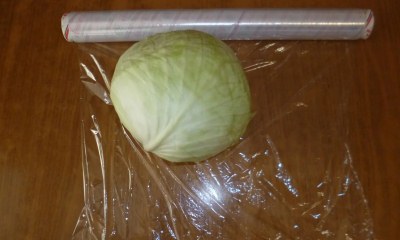 for cabbage to be well stored, it is enough to wrap it in 4 layers of film;
for cabbage to be well stored, it is enough to wrap it in 4 layers of film;- the material should be pressed as tightly as possible to the surface of the vegetable - this rule is especially true for cut heads;
- in the refrigerator, forks are placed in a vegetable box or on an ordinary shelf, whole heads of cabbage can stay fresh for up to 4 months;
- in the cellar, cabbage wrapped in foil is folded into boxes, in this form it can be stored for 3-4 months.
A freezer for storing forks is not suitable. You can only freeze processed cabbage, for example, stewed or sauerkraut.
He will tell you how to properly store cabbage in the refrigerator this article about storage in the cellar - this... Read how to freeze stewed cabbage here.
Reviews
People who have stored cabbage in cling film leave different reviews about this method. Most of them indicate that the vegetable in polyethylene grows moldy.... This happens when it is in the film for a long time.
Some tried to sprinkle the cabbage with flour before placing it in cellophane, but this did not save it from the growth of the fungus.
Helpful information
Tips for storing cabbage in film:
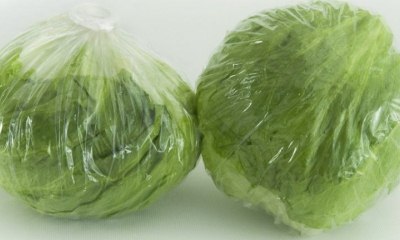 To simplify your task, you need to get a film, the width of which is 35-45 cm. If its size is larger or smaller, it will be inconvenient to wrap the heads of cabbage.
To simplify your task, you need to get a film, the width of which is 35-45 cm. If its size is larger or smaller, it will be inconvenient to wrap the heads of cabbage.- If a large amount of moisture has formed inside, the film must be removed, dried forks, inspected for damage and wrapped in a new layer of polyethylene.
- Fresh cabbage should not be frozen. After cooling, it becomes soft and tasteless. It is impossible to consume it fresh, and during heat treatment it quickly boils down.
- A kind of microclimate is formed under the film, which is not recommended to be violated. If there are no signs of spoilage, and there is not too much moisture inside, the cabbage is not unwrapped.
Related Videos
The video will tell you about storing cabbage in cling film:
Conclusion
You can store cabbage in cling film. With the right approach, whole forks can stay fresh for up to 4 months and cut forks for up to 2 weeks. The main thing is that the air temperature does not exceed +1 degrees.


